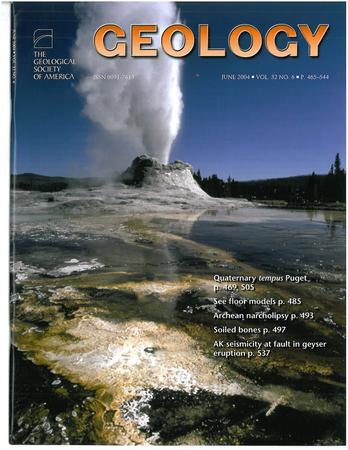Early Emperor seamount evolution and geotectonics of the northwestern Pacific plate
IF 4.6
1区 地球科学
Q1 GEOLOGY
引用次数: 0
Abstract
Our knowledge of the Cretaceous history of the northwestern Pacific plate relies on tectonic reconstructions that lack geochronologic and geochemical constraints due to the paucity of sampling in this area. We present new age and compositional data for samples from four Emperor seamounts: Meiji, Hanzei, Suizei, and Tenji. Tholeiites from Tenji (66 Ma) and Suizei (70 Ma) yield ages consistent with the expected age progression, whereas a trachytic sample from Hanzei (66 Ma, expected age of ca. 73 Ma) represents an alkalic post-shield event. The ridge-like morphology and depleted geochemistry of Meiji to Suizei seamounts and the age (78−75 Ma) and depleted composition of the volcanic elongated ridges (VERs) southeast of Detroit seamount (ca. 76 Ma) are consistent with plume-ridge interaction. The VERs account for the missing volume of volcanism expected from plume-ridge interaction for the oldest Emperor seamounts. A small seamount with mid-ocean ridge basalt−like geochemistry located east of northern Detroit seamount yielded an age of 100 Ma, representing a minimum age for the oceanic crustal sliver between the Emperor Trough and the Stalemate Fracture Zone. We propose ∼300 km of dextral offset along the Emperor Trough to explain the location of this older crustal sliver. Our new data provide important constraints on the poorly known early evolution of the Hawaiian-Emperor Seamount Chain and the Cretaceous Quiet Zone (Cretaceous Normal Superchron) geotectonic history of the northwestern Pacific plate.早帝海山演化与西北太平洋板块大地构造
我们对西北太平洋板块白垩纪历史的认识依赖于构造重建,由于该地区采样的缺乏,缺乏地质年代学和地球化学的限制。本文报道了明治、汉泽、绥靖和天济四个皇帝海山样品的新时代和成分数据。来自天济(66 Ma)和绥泽市(70 Ma)的拉斑岩的生成年龄与预期的年龄进展一致,而来自汉泽的粗质样品(66 Ma)的预期年龄约为73 Ma,代表了碱性屏蔽后事件。明治-绥泽海山的脊状形态和贫化地球化学特征,以及底特律海山东南部(约76 Ma)火山细长脊的年龄(78 ~ 75 Ma)和贫化组成与羽脊相互作用一致。VERs解释了最古老的帝王海山的羽状脊相互作用中火山活动的缺失量。位于底特律海山北部东部的一个具有洋中脊玄武岩样地球化学特征的小海山测定了100 Ma的年龄,代表了皇帝槽和相合断裂带之间海洋地壳银条的最小年龄。我们提出沿帝王海槽的约300公里的右偏移来解释这个更古老的地壳银条的位置。我们的新资料对夏威夷-皇帝海山链的早期演化和西北太平洋板块白垩纪静息带(白垩纪正常超时)大地构造史提供了重要的约束。
本文章由计算机程序翻译,如有差异,请以英文原文为准。
求助全文
约1分钟内获得全文
求助全文
来源期刊

Geology
地学-地质学
CiteScore
10.00
自引率
3.40%
发文量
228
审稿时长
6.2 months
期刊介绍:
Published since 1973, Geology features rapid publication of about 23 refereed short (four-page) papers each month. Articles cover all earth-science disciplines and include new investigations and provocative topics. Professional geologists and university-level students in the earth sciences use this widely read journal to keep up with scientific research trends. The online forum section facilitates author-reader dialog. Includes color and occasional large-format illustrations on oversized loose inserts.
 求助内容:
求助内容: 应助结果提醒方式:
应助结果提醒方式:


